
4) Trade-off decisions between effectiveness and efficiency are important in the practice of strategic management.
⊚ true
⊚ false
5) According to Henry Mintzberg, a management scholar, most firms do not realize their original intended strategy.
⊚ true
⊚ false
6) The final realized strategy of a firm is a combination of deliberate and time-tested strategies only.
⊚ true
⊚ false
7) Strategy analysis is the study of only the big picture external environments of the firm.
⊚ true
⊚ false
8) All successful firms compete and outperform their rivals by developing bases for competitive advantage, which can be achieved only through cost leadership.
⊚ true
⊚ false
9) The three primary participants in corporate governance are: (1) the shareholders, (2) the management (led by the chief executive officer), and (3) the employees.
⊚ true
⊚ false
10) Decisions by boards of directors are always consistent with shareholder interests.
⊚ true
⊚ false
11) Ensuring effective corporate governance requires an effective and engaged board of directors, uninvolved shareholders, and proper managerial rewards and incentives.
⊚ true
⊚ false
12) Social responsibility is the idea that organizations are only accountable to stockholders.
⊚ true
⊚ false
13) Shell, NEC, and Procter and Gamble have been measuring their performance according to what has been called a triple bottom line. This technique involves an assessment of financial, social, and environmental performance.
⊚ true
⊚ false
14) Sustainability is being increasingly recognized as a source of cost efficiencies and revenue growth.
⊚ true
⊚ false
15) Strategic management requires managers at all levels of the organization to take a segregated view of the organization.
⊚ true
⊚ false
16) The strategic management process should be addressed only by top-level executives. Midlevel and low-level employees are best equipped to implement the strategies of the organization.
⊚ true
⊚ false
17) Richard Branson, the founder of the Virgin Group, is well known for creating an inclusive organizational structure in which anybody in the organization can be involved in generating and acting on new business ideas.
⊚ true
⊚ false
18) The vision of an organization is at the top level of its hierarchy of organizational goals. The vision statement should be massively inspiring, overarching, and long term.
⊚ true
⊚ false
19) Much research has supported the notion that individuals work much harder when they are asked to do their best rather than when they are striving toward a specific goal.
⊚ true
⊚ false
Another random document with no related content on Scribd:
fishermen fish for them in 400 or 500 fathoms with a line of some 600 fathoms in length. The Sharks caught were specimens of Centrophorus coelolepis, from three to four feet long. “These sharks, as they were hauled into the boat, fell down into it like so many dead pigs; there was not the smallest motion of their bodies. There can be no reasonable doubt that they were inhabitants of the same great depth as Hyalonema” and that, in fact, they were killed by being dragged to the surface from the pressure of water under which they lived. The dermal productions of some of the species have a very peculiar form, being leaf-shaped, pedunculate, or ribbed, or provided with an impression.
S�����. Each dorsal fin with a spine. Teeth of the lower jaw with the point so much turned aside that the inner margin of the tooth forms the cutting edge. Upper teeth erect, each with a long-pointed cusp and one or two small ones on each side Spiracles wide, superior, behind the eye
Three small species from the Atlantic and the southern extremity of America. Centroscyllium is an allied genus from the coast of Greenland.
S������. Two short dorsal fins without spine, the first at a considerable distance from the ventrals. Dermal productions uniformly small. Nostrils at the extremity of the snout. Upper teeth small, pointed; lower much larger, dilated, erect, triangular, not very numerous Spiracles wide
A single species, S. lichia, is rather common in the Mediterranean and the neighbouring parts of the Atlantic.
L�������. All the fins small; two dorsal fins, without spine, the first at a considerable distance from the ventrals. Skin uniformly covered with minute tubercles. Nostrils near the extremity of the snout. The upper teeth small, narrow, conical; the lower teeth numerous, in several series, the point so much turned aside that the inner margin forms a cutting, non-serrated edge. Jaws feeble. Spiracles of moderate width
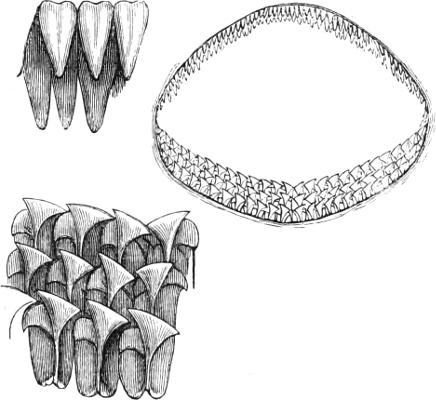
The “Greenland Shark” is an inhabitant of the Arctic regions, but rarely straying to the latitudes of great Britain; it grows to a length of about 15 feet, and, although it never or but rarely attacks man, is one of the greatest enemies of the whale, which is often found with large pieces bitten out of the tail by this Shark. Its voracity is so great that, according to Scoresby, it is absolutely fearless of the presence of man whilst engaged in feeding on the carcass of a whale, so that it can be pierced through with a spear or knife without being driven away It is stated to be viviparous, and to produce about four young at a birth.
Fig. 123.—Dentition of the Greenland Shark. Some teeth are represented of the natural size; those of the lower jaw in three series.
Fig. 124. Læmargus borealis, Greenland Shark.
E����������� Two very small dorsal fins, without spine, the first opposite to the ventrals Skin with scattered large round tubercles Nostrils midway between the mouth and the end of the snout Teeth equal in both jaws, very oblique, the point being turned outwards; several strong denticulations on each side of the principal point Spiracles small
The “Spinous Shark” is readily recognised by the short bulky form of its body, short tail, and large spinous tubercles. It is evidently a ground-shark, which probably lives at some depth and but accidentally comes to the surface. More frequently met with in the Mediterranean, it has been found several times on the south coast of England, and near the Cape of Good Hope.
Euprotomicrus and Isistius are two other genera of this family; they are pelagic and but little known.
N���� F�����—R������.
No anal fin; two dorsal fins. Spiracles present. Pectoral fins large, with the basal portion prolonged forwards, but not grown to the head.
R���� —Head and body depressed, flat; mouth anterior Gillopenings rather wide, lateral, partly covered by the base of the pectoral. Spiracles wide, behind the eyes. Teeth conical, pointed, distant. Dorsal fins on the tail.
The “Angel-fish,” or “Monk-fish” (Rh. squatina), approaches the Rays as regards general form and habits. Within the temperate and tropical zones it is almost cosmopolitan, being well known on the coasts of Europe, eastern North America, California, Japan, South Australia, etc.; it does not seem to exceed a length of five feet; it is viviparous, producing about twenty young at a birth.
Extinct forms, closely allied to the “Angel-fish,” are found in the Oolite, and have been described as Thaumas. The carboniferous genus, Orthacanthus, may have been allied to this family, but it was armed with a spine immediately behind the head.
T���� F�����—P�������������.
The rostral cartilage is produced, into an exceedingly long, flat lamina, armed along each edge with a series of teeth (saw).
These Sharks resemble so much the common Saw-fishes as to be easily confounded with them, but their gill-openings are lateral, and not inferior. They are also much smaller in size, and a pair of long tentacles are inserted at the lower side of the saw. The four species known (Pristiophorus) occur in the Australian and Japanese seas.
Squaloraja, from the Lias, is supposed to have its nearest affinities to this family.
B. B�������—R���.
In the typical Rays the body is excessively depressed, and forms, with the expanded pectoral fins, a circular or sub-rhomboidal disk, of which the slender tail appears as a more or less long appendage. In the two families which we shall place first (Pristidæ and Rhinobatidæ), the general habit of the body still resembles that of the Sharks, but the gill-openings are ventral, as in the true Rays; the anal fin is invariably absent, and the dorsal fins, if developed, are placed on the tail. The mode of life of those fishes is quite in accordance with the form of their body. Whilst the species with a shark-like body and muscular tail swim freely through the water, and are capable of executing rapid and sustained motions, the true Rays lead a sedentary life, moving slowly on the bottom, rarely ascending to the surface. Their tail has almost entirely lost the function of an organ of locomotion, acting in some merely as a rudder. They progress solely by means of the pectoral fins, the broad and thin
margins of which are set in an undulating motion, entirely identical with that of the dorsal and anal fins of the Pleuronectidæ. They are exclusively carnivorous, like the Sharks, but unable to pursue and catch rapidly-moving animals; therefore they feed chiefly on molluscous and crustaceous animals. However, the colour of their integuments assimilates so closely that of their surroundings, that other fishes approach them near enough to be captured by them. The mouth of Rays being entirely at the lower surface of the head, the prey is not directly seized with the jaws; but the fish darts over its victim so as to cover and hold it down with its body, when it is conveyed by some rapid motions to the mouth.
Rays do not descend to the same depth as Sharks; with one exception,[37] at least, none have been known to have been caught by a dredge worked in more than 100 fathoms. The majority are coast fishes, and have a comparatively limited geographical range, none extending from the northern temperate zone into the southern. However, some, if not all the species of the family Myliobatidæ, which includes the giants of this division of Plagiostomes, have a claim of being included among the Pelagic fishes, as they are frequently met with in the open ocean at a great distance from the shore. It is probable that the occurrence of such individuals in the open sea indicates the neighbourhood of some bank or other comparatively shallow locality. Many species are exclusively confined to fresh water, and occur far inland, especially in tropical America.
The majority are oviparous. All have five pairs of gill-openings. The number of known species is about the same as that of Sharks, viz. 140.
F���� F�����—P�������.The snout is produced into an exceedingly long flat lamina, armed with a series of strong teeth along each edge (saw).
P������. Body depressed and elongate, gradually passing into the strong and muscular tail. Pectoral fins, with the front margins quite
free, not extending to the head. No tentacles below the saw. Teeth in the jaws minute, obtuse. Dorsal fins without spine, the first opposite or close to the base of the ventrals
“Saw-fishes.” Abundant in tropical, less so in sub-tropical seas. They attain to a considerable size, specimens with a saw 6 feet long and 1 foot broad at the base not being of uncommon occurrence. The saw, which is their weapon of attack, renders them most dangerous to almost all the other large inhabitants of the ocean. Its endoskeleton consists of three, sometimes five, rarely four, hollow cylindrical tubes, placed side by side, tapering towards the end, and incrusted with an osseous deposit. These tubes are the rostral processes of the cranial cartilage, and exist in all Rays, though in them they are shorter and much less developed. The teeth of the saw are implanted in deep sockets of the hardened integument. The teeth proper, with which the jaws are armed, are much too small for inflicting wounds or seizing other animals. Saw-fishes use this weapon in tearing pieces of flesh off an animal’s body or ripping open its abdomen. The detached fragments or protruding soft parts are then seized by them and swallowed. Five distinct species of Saw-fishes are known.
Saws of extinct species have been found in the London clay of Sheppey and in the Bagshot sands.
S����� F�����—R����������.
Tail strong and long, with two well-developed dorsal fins, and a longitudinal fold on each side; caudal developed. Disk not excessively dilated, the rayed portion of the pectoral fins not being continued to the snout.
R�����������. Dorsal fins without spine, the first opposite to the ventrals Caudal fin with the lower lobe well developed Teeth obtuse, granular, the dental surfaces of the jaws being undulated
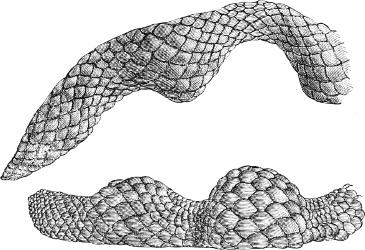
Two species, Rh. ancylostomus and Rh. djeddensis, are very common on the tropical coasts of the Indian Ocean. They feed on hard-shelled animals, and attain scarcely a length of 8 feet.
R��������� Cranial cartilage produced into a long rostral process, the space between the process and pectoral fin being filled by a membrane Teeth obtuse, with an indistinct transverse ridge Dorsal fins without spine, both at a great distance behind the ventral fins. Caudal fin without lower lobe.
Numerous on the coasts of tropical and sub-tropical seas; about twelve species. Trygonorhina is an allied genus from South Australia.
The oolitic genus Spathobatis is scarcely distinct from Rhinobatus; and another fossil from Mount Lebanon has been actually referred to this latter genus. Trigorhina from Monte Postale must be placed here.
T���� F�����—T����������.
The trunk is a broad, smooth disk. Tail with a longitudinal fold on each side; a rayed dorsal fin is generally, and a caudal always, present. Anterior nasal valves confluent into a quadrangular lobe. An electric organ composed of vertical hexagonal prisms between the pectoral fins and the head.
Fig. 125. Dentition of Rhynchobatus.“Electric Rays.” The electric organs with which these fishes are armed are large, flat, uniform bodies, lying one on each side of the head, bounded behind by the scapular arch, and laterally by the anterior crescentic tips of the pectoral fins. They consist of an assemblage of vertical hexagonal prisms, whose ends are in contact with the integuments above and below; and each prism is subdivided by delicate transverse septa, forming cells, filled with a clear, trembling, jelly-like fluid, and lined within by an epithelium of nucleated corpuscles. Between this epithelium and the transverse septa and walls of the prism there is a layer of tissue on which the terminations of the nerves and vessels ramify. Hunter counted 470 prisms in each battery of Torpedo marmorata, and demonstrated the enormous supply of nervous matter which they receive. Each organ receives one branch of the Trigeminal nerve and four branches of the Vagus, the former, and the three anterior branches of the latter, being each as thick as the spinal chord (electric lobes). The fish gives the electric shock voluntarily, when it is excited to do so in selfdefence or intends to stun or to kill its prey; but to receive the shock the object must complete the galvanic circuit by communicating with the fish at two distinct points, either directly or through the medium of some conducting body. If an insulated frog’s leg touches the fish by the end of the nerve only, no muscular contractions ensue on the discharge of the battery, but a second point of contact immediately produces them. It is said that a painful sensation may be produced by a discharge conveyed through the medium of a stream of water. The electric currents created in these fishes exercise all the other known powers of electricity: they render the needle magnetic, decompose chemical compounds, and emit the spark. The dorsal surface of the electric organ is positive, the ventral surface negative.
[The literature on the electric organ of Torpedo is very extensive. Here may be mentioned Lorenzini, “Osservazioni intorno alle Torpedini,” (1678); Walsh, “On the Electric Property of the Torpedo,” in Philos. Trans., 1773; Hunter, “Anatomical Observations on the Torpedo,” ibid ; Davy, “Observations on the Torpedo,” in Philos Trans , 1834; Matteucci and Savi, “Traité des Phénomènes ElectroPhysiologiques,” 1844 ]
Of the genus Torpedo six species are known, distributed over the Atlantic and Indian Oceans; three of them are rather common in the Mediterranean, and one (T. hebetans) reaches the south coast of England. They attain to a width of from two to three feet, and specimens of that size are able to disable by a single discharge a full-grown man, and, therefore, may prove dangerous to bathing persons. Other genera, differing from Torpedo in the position and structure of some of the fins, are found in other tropical and subtropical seas, viz. Narcine, Hypnos, Discopyge (Peru), Astrape, and Temera. All, like electric fishes generally, have a naked body
A large fish, of the general appearance of a Torpedo, has been found at Monte Bolca; and Cyclobatis, from the upper cretaceous limestone of Lebanon, is probably another extinct representative of this family.
F����� F�����—R�����.
Disk broad, rhombic, generally with asperities or spines; tail with a longitudinal fold on each side. The pectoral fins extend to the snout. No electric organ; no serrated caudal spine.
R���. Two dorsal fins on the tail, without spine; tail with a rudimentary caudal fin, or without caudal. Each ventral fin divided into two by a deep notch Teeth small, obtuse, or pointed Pectoral fins not extending forwards to the extremity of the snout Nasal valves separated in the middle, where they are without a free margin (see Fig 1, p 34)
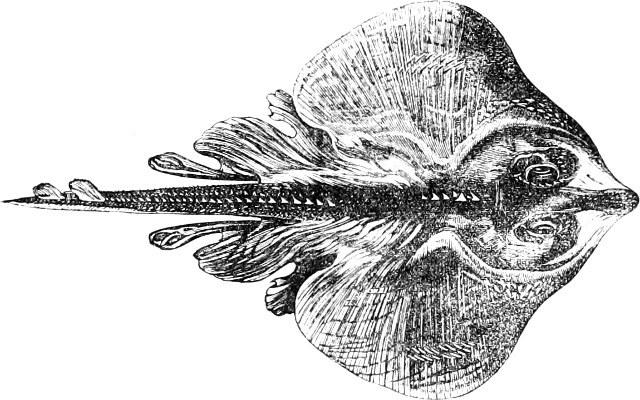
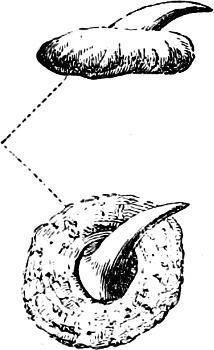 Fig. 126. Raja lemprieri, from Tasmania.
Fig. 127. Dermal spines of a male Thornback, Raja clavata.
Fig. 126. Raja lemprieri, from Tasmania.
Fig. 127. Dermal spines of a male Thornback, Raja clavata.
Of all the genera of Batoidei, Rays have the widest geographical range; they are chiefly inhabitants of temperate seas, and much more numerous in those of the Northern than of the Southern Hemisphere. They advance more closely to the Arctic and Antarctic circles than any other member of this group. More than thirty species are known, of which the following are found on the British coast:— The Thornback (R. clavata), the Homelyn Ray (R. maculata), the Starry Ray (R. radiata), the Sandy Ray (R. circularis), the common Skate (R. batis), the Burton Skate (R. marginata), and the Shagreen Skate (R. fullonica). Some of these species, especially the Skates, attain a considerable size, the disk measuring six and even seven feet across. All are eatable, and some of them regularly brought to market. In the majority of the species peculiar sexual differences have been observed. In some, as in the Thornback, all or some of the teeth are pointed in the male sex, whilst they are obtuse and flat in the female. The males of all are armed with patches of claw-like spines, retractile in grooves of the integument, and serially arranged occupying a space on the upper side of the pectoral fin near the angle of the disk, and frequently also the sides of the head. In species which are armed with bucklers or asperities it is the female which is principally provided with these dermal productions, the male being entirely or nearly smooth. Also the colour is frequently different in the two sexes.
Other genera of this family are Psammobatis, Sympterygia, and Platyrhina. Although probably this family was well represented in cretaceous and tertiary formations, the remains found hitherto are comparatively few. Arthropterus, from the Lias, seems to have been a true Ray; and dermal spines of a species allied to the Thornback (Raja antiqua) are abundant in the crag deposits of Suffolk and Norfolk.
F���� F�����—T��������.
The pectoral fins are uninterruptedly continued to, and confluent at, the extremity of the snout. Tail long and slender, without lateral
longitudinal folds; vertical fins none, or imperfectly developed, often replaced by a strong serrated spine.
The “Sting-Rays” are as numerous as the Rays proper, but they inhabit rather tropical than temperate seas. The species armed with a spine use it as a weapon of defence, and the wounds inflicted by it are, to man, extremely painful, and have frequently occasioned the loss of a limb. We have mentioned above (p. 190) that the danger arises from the lacerated nature of the wound as well as from the poisonous property of the mucus inoculated. The spines (Fig. 98, p. 190) are always barbed on the sides, and may be eight or nine inches long in the larger species. They are shed from time to time, and replaced by others growing behind the one in function, as the teeth of the fishes of this order, or as the fangs of a poisonous snake. Fossil species of Trygon and Urolophus occur in the tertiary strata of Monte Bolca and Monte Postale. The genera into which the various species have been divided are the following:—
U��������.—Tail long, without fin or spine, sometimes with a narrow cutaneous fold below. Body densely covered with osseous tubercles. Teeth flattened.
Only one species is known (U. asperrimus), common in the Indian Ocean, and with a body from 4 to 5 feet long; the skin is frequently used for covering shields and the handles of swords and other weapons, its rough surface offering a firm hold to the hand.
T�����. Tail very long, tapering, armed with a long arrowshaped barbed spine. Body smooth or with tubercles. Nasal valves coalescent into a quadrangular flap. Teeth flattened.
Some twenty-five species are known, one of which (T. pastinaca) extends from the south coast of England and the east coast of North America through the Atlantic and Indian Ocean to Japan. The majority of the species belong to the tropical parts of the Indian and Atlantic Oceans; some inhabit exclusively freshwaters of eastern tropical America. A closely allied genus is Tæniura, with six species.
U�������� Tail of moderate length, with a distinct rayed terminal fin, armed with a barbed spine, without or with a rudimentary dorsal fin Teeth flattened
Seven species from tropical seas, apparently of small size.
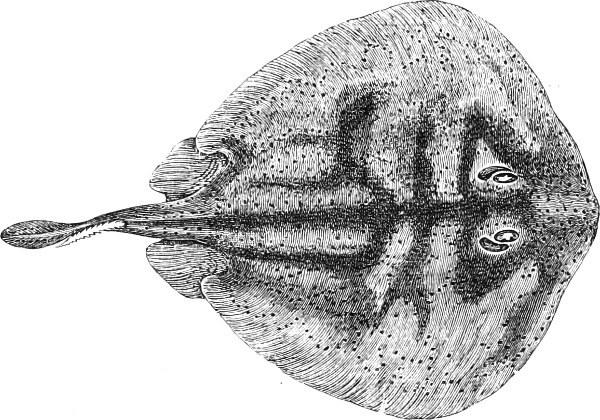
Australia
P����������. Body at least twice as broad as long; tail very short and thin, without or with a rudimentary fin, and with a serrated spine. Teeth very small, uni- or tri-cuspid.
Six species from temperate and tropical seas.
S���� F�����—M����������.
The disk is very broad, in consequence of the great development of the pectoral fins, which, however, leave the sides of the head free, and reappear at the extremity of the snout as a pair of detached (cephalic) fins. Viviparous.
“Devil-fishes,” “Sea-devils,” or “Eagle-rays.” Generally of large size, inhabiting temperate and tropical seas. Some genera possess a pair of singular cephalic processes, which generally project in a
Fig 128 Urolophus cruciatus, fromdirection parallel to the longitudinal axis of the body, but are said to be flexible in the living fish, and used for scooping food from the bottom and conveying it to the mouth. In all the species the dentition consists of perfectly flat molars, forming a kind of mosaic pavement in both the upper and lower jaws: a most perfect mechanical arrangement for crushing alimentary substances.
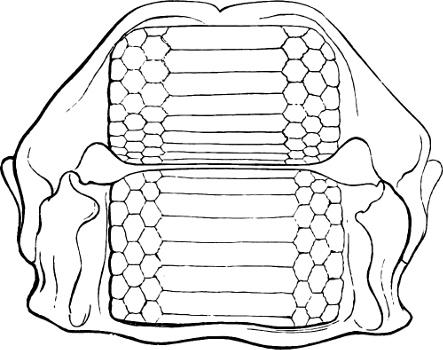
M��������� Teeth sexangular, large, flat, tessellated, those in the middle much broader than long; several narrower series on each side Tail very long and thin, with a dorsal fin near its root; generally a serrated spine behind the fin
Seven species are known, two of which are European, one (M. aquila) being almost cosmopolitan, and occasionally found on the British coast. The young differ much from the adult, having no median series of larger teeth, but all the teeth of equal size and regularly sexangular. Also the tail is much longer in young examples than in old ones, and the coloration more ornamental. Teeth of species very closely allied to, or perhaps even identical with, existing species, are found in tertiary formations.
Fig. 129. Jaws of an Eagle-Ray, Myliobatis aquila.A��������. Form of the head, body, and tail as Myliobatis. The nasal valves remain separate, each forming a long flap. The lower dental lamina projects beyond the upper Teeth flat, broad, forming a single series, equivalent to the median series of Myliobatis, there being no small lateral teeth
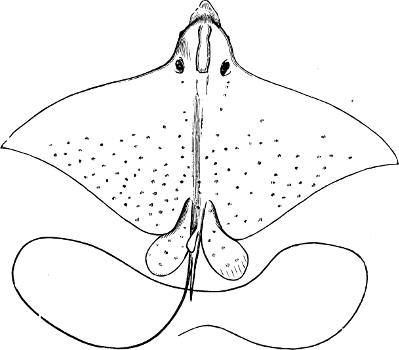
One species only (A. narinari) which is found in almost all tropical seas, and of exceedingly common occurrence in the Atlantic and Indian Oceans; it does not seem to grow to a very large size (perhaps not exceeding 5 feet in width), and is readily recognised by numerous round bluish-white spots, with which the back is ornamented. Fossils of this genus occur in the English Eocenes and the Swiss Molasse.
Fig. 130. Aëtobatis narinari.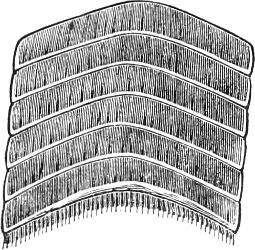
R���������.—The cephalic appendages are bent inwards, and situated at the lower side of the snout. Nasal valves confluent into a broad flap, with free margin. Teeth broad, flat, tessellated, in five or more series, the middle being the broadest, and the others decreasing in width outwards. Tail very slender, with a dorsal fin before the serrated spine.
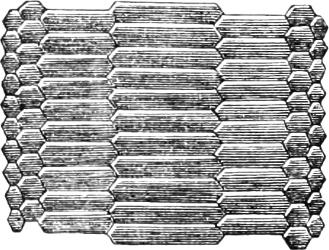 Fig. 131. Aëtobatis subarcuatus, from Bracklesham.
Fig. 132. Rhinoptera woodwardi; fossil.
Fig. 131. Aëtobatis subarcuatus, from Bracklesham.
Fig. 132. Rhinoptera woodwardi; fossil.
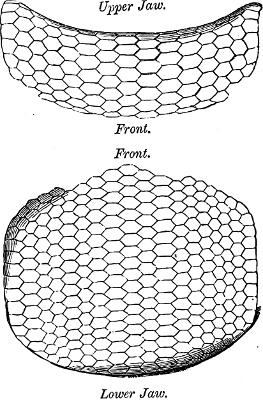
Seven species from tropical and sub-tropical seas are known; of Rhinoptera polyodon nothing is known except the jaws; and as its dentition is very peculiar, no opportunity should be lost of obtaining and preserving entire animals. Teeth very similar to those of existing species, and described as Zygobatis, occur in the Norwich Crag and in Miocene formations of Switzerland.
D���������� (C�����������). Cephalic appendages pointing straight forwards or inwards. Nostrils widely separated from each other Mouth inferior, wide Both jaws with very numerous and very small flat or tubercular teeth Tail very slender, with a dorsal fin between the ventrals, and with or without a serrated spine
C����������. Cephalic appendages pointing forwards or inwards. Mouth anterior; wide. Teeth in the lower jaw only, very small. Tail very slender, with a dorsal fin between the ventrals and without spine.
Fig. 133.—Rhinoptera polyodon.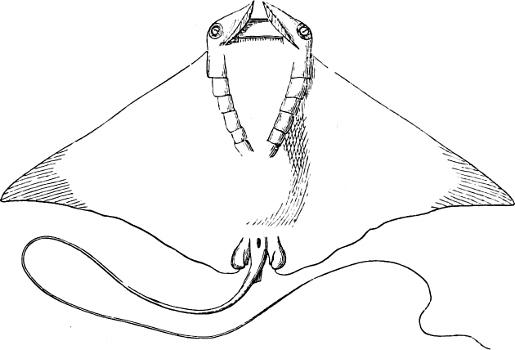
The species of these two last genera are not yet well distinguished; about five of Dicerobatis and two of Ceratoptera are known from tropical and temperate seas, but their occurrence in the latter is rather sporadic. Some of them, if not all, attain an enormous size. One mentioned by Risso, taken off Messina, weighed 1250 pounds. Several observers speak of having seen them in pairs, the male being usually the smaller. Of a pair mentioned by Risso the female was first taken, and the male remained hovering about the boat for three days, and was afterwards found floating dead on the surface. Still larger individuals, but of uncertain species, are mentioned by Lacépède, who says that one taken at Barbadoes required seven yoke of oxen to draw it. A sketch of another, which was said to be twenty feet long, was sent to Lacépède; and Sonnini speaks of one which appeared to him to be longer and wider than the ship in which he was sailing. A fœtus taken from the uterus of the mother captured at Jamaica, and preserved in the British Museum, is five feet broad, and weighed twenty pounds. The mother measured fifteen feet in width as well as in length, and was between three and four feet thick. The capture of “Devil-fishes” of such large size is
Fig. 134. Dicerobatis draco, from Misol.attended with danger, as they not rarely attack and capsize the boat. They are said to be especially dangerous when they accompany their young, of which they bring forth one only at a time.
SECOND SUB-ORDER HOLOCEPHALA
One external gill-opening only, covered by a fold of the skin, which encloses a rudimentary cartilaginous gill-cover; four branchial clefts within the gill-cavity. The maxillary and palatal apparatus coalescent with the skull.
This suborder is represented in the living fauna by one family only, Chimæridæ; it forms a passage to the following order of fishes, the Ganoids. In external appearance, and with regard to the structure of their organs of propagation, the Chimæras are Sharks (See Fig. 96, p. 184). The males are provided with “claspers” in connection with the ventral fins, and the ova are large, encased in a horny capsule, and few in number; and there is no doubt that they are impregnated within the oviduct, as in Sharks. Chimæras are naked, but, as in Scylliidæ, very young individuals possess a series of small “placoid” spines, which occupy the median line of the back, and remind us of similar dermal productions in the Rays. The males, besides, are provided with a singular erectile appendage, spiny at its extremity, and received in a groove on the top of the head. On the other hand, the relations of the Chimæras to the Ganoid, and, more especially, Dipnoous type become manifest in their notochordal skeleton and continuity of cranial cartilage. The spine in front of the first dorsal fin is articulated to the neural apophysis, and not merely implanted in the soft parts, and immovable as in Sharks. A cartilaginous operculum makes its appearance, and the external gillopening is single. The dentition is that of a Dipnoid, each “jaw” being armed with a pair of broad dental plates, with the addition of a pair of smaller cutting teeth in the upper “jaw.” Fossils of similar dental combination are not rare in strata, commencing from the Lias and the bottom of the Oolitic series; but it is impossible to decide in every case whether the fossil should be referred to the Holocephalous or Dipnoous type. According to Newberry, Chimæroid fishes commence in the Devonian with Rhynchodus, the remains of which were
discovered by him in Devonian rocks of Ohio. Undoubted Chimæroids are Elasmodus, Psaliodus, Ganodus, Ischyodus, Edaphodon, and Elasmognathus, principally from mesozoic and tertiary formations. Very similar fossils occur in the corresponding strata of North America. A single species of Callorhynchus has been discovered by H. Hector in the Lower Greensand of New Zealand.
The living Chimæras are few in number, and remain within very moderate dimensions, probably not exceeding a length of five feet, inclusive of their long filamentous, diphycercal tail. They are referred to two genera.
C������ Snout soft, prominent, without appendage The dorsal fins occupying the greater part of the back, anterior with a very strong and long spine Longitudinal axis of the tail nearly the same as that of the trunk, its extremity being provided with a low fin above and below, similar in form to a dorsal and anal fin Anal fin very low
Three species are known: Ch. monstrosa, from the coasts of Europe and Japan and the Cape of Good Hope; Ch. colliei from the west coast of North America; and Ch. affinis from the coast of Portugal. (See Fig. 96, p. 184.)
C������������ —Snout with a cartilaginous prominence, terminating in a cutaneous flap. Two dorsal fins, the anterior with a very strong and long spine. Extremity of the tail distinctly turned upwards, with a fin along its lower edge, but without one above. Anal fin close to the caudal, short and deep.
One species (C. antarcticus) is common in the Southern temperate zone. Cunningham describes the egg (see Fig. 81, p. 169), as being of a dark greenish-black colour, and, in general, measuring from eight to nine or even ten inches in length, by about three in breadth. It consists of a central, somewhat spindle-shaped convex area (between the horny walls of which the young fish lies), surrounded by a broad plicated margin, which is fringed at the edge, and covered on the under surface with fine light brownish-yellow hairs.
